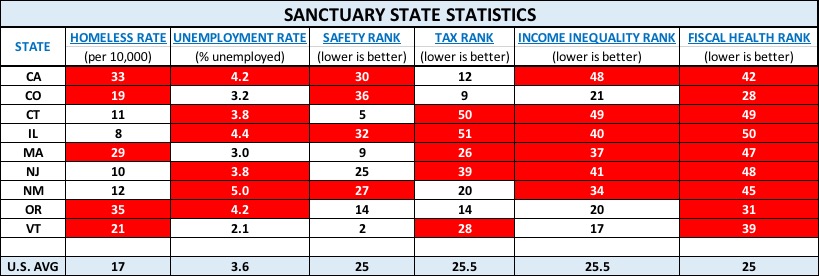INTENTIONS ARE GOOD, OUTCOMES ARE BAD …
As so-called “sanctuary” states, counties and cities continue thwarting Immigration and Customs Enforcement (ICE) efforts to enforce U.S. immigration law and deport illegal immigrants, we thought it would be instructive to research whether American citizens living in sanctuary jurisdictions actually benefit from such radical policy … or if the excessive financial and social burden of welcoming and protecting scores of illegal aliens is detrimental to society.

But, first, a few definitions and delineations …
The Center for Immigration Studies (CIS) defines “sanctuary” jurisdictions as follows:
Sanctuary cities, counties, and states have laws, ordinances, regulations, resolutions, policies, or other practices that obstruct immigration enforcement and shield criminals from Immigration Control and Enforcement (ICE) — either by refusing to or prohibiting agencies from complying with ICE detainers, imposing unreasonable conditions on detainer acceptance, denying ICE access to interview incarcerated aliens, or otherwise impeding communication or information exchanges between their personnel and federal immigration officers.
A detainer is the primary tool used by ICE to gain custody of criminal aliens for deportation. It is a notice to another law enforcement agency that ICE intends to assume custody of an alien and includes information on the alien’s previous criminal history, immigration violations, and potential threat to public safety or security.
And here is a map, created by the Center for Immigration Studies, and updated on 16 April 2019, that pinpoints sanctuary cities (red), counties (yellow) and states (green).

For the sake of our study, we will direct our focus on the nine self-designated sanctuary states — California, Colorado, Connecticut, Illinois, Massachusetts, New Jersey, New Mexico, Oregon and Vermont.
Specifically, we will explore whether sanctuary state policies either cause and / or, at the very least, exacerbate existing negative outcomes, namely: higher homeless rates, higher unemployment rates, lower safety, higher taxes, higher income inequality, and poorer state fiscal health.
The table below presents sanctuary state ratings and rankings on the aforementioned outcomes. Red filled boxes with white numbers indicate state statistics worse than the U.S. average.

Homeless Rate: U.S. Dept. of HUD
Unemployment Rate: U.S. Dept. of BLS
Safety Rate: WalletHub
Tax Rank: WalletHub
Income Inequality Rank: Wikipedia / Gini Coefficient
Fiscal Health Rank: Mercatus Center
Here is a percentage summary on each finding:
HOMELESS RATE: Five of nine (56%) sanctuary states had worse than average homeless rates.
UNEMPLOYMENT RATE: Six of nine (67%) sanctuary states had worse than average unemployment rates.
SAFETY RANK: Four of nine (44%) sanctuary states had a worse than average safety ranking.
TAX RANK: Five of nine (56%) sanctuary states had a worse than average tax ranking.
INCOME INEQUALITY RANK: Six of nine (67%) sanctuary states had a worse than average income inequality ranking.
FISCAL HEALTH RANK: Nine of nine (100%) sanctuary states had a much worse than average fiscal health ranking.
For each outcome we studied except one (Safety), a plurality of sanctuary states scored worse than the average U.S. state. Therefore, we conclude that sanctuary policies are detrimental to state citizens and government finances.
Citizen safety seems to be the only outcome studied that generally does not appear to be negatively impacted by sanctuary policies. However, one can never forget the handful of very public and tragic civilian deaths (e.g. Kate Steinle) at the hands of illegal immigrants protected by sanctuary policies. And, certainly, ICE agents will argue that sanctuary policies put their lives in greater danger, forcing them to make more at-large arrests in immigrant communities – at workplaces, dwellings, and on the street, rather than in controlled jail or courthouse environments.
Naturally, besides providing taxpayer-funded legal advice, education and medical care to illegal aliens, progressive government policies also attract mostly poor, uneducated and homeless illegal immigrants to their states, putting enormous pressure on public shelters, job opportunities, unskilled worker wages, social welfare and health programs and, consequently, the state’s fiscal health.
We believe it is no coincidence that 100% of sanctuary states are governed by a Democratic State House and Democratic State Senate, and seven of nine or 78% by Democratic Governors. Massachusetts and Vermont are the only two sanctuary states with elected Republican (in name only) Governors. And we’re confident that sanctuary county and city governments are similarly dominated by Democrats.
BOTTOM LINE: While progressive Democrats’ intentions are noble in helping illegal (and sometimes even criminal) immigrants seeking a better life in the United States, sanctuary policies put ICE agent lives in jeopardy, and disproportionately impact poor, lower-middle-class and minority American citizens, raise the cost of living and doing business via rising taxes, and threaten state financial viability.
